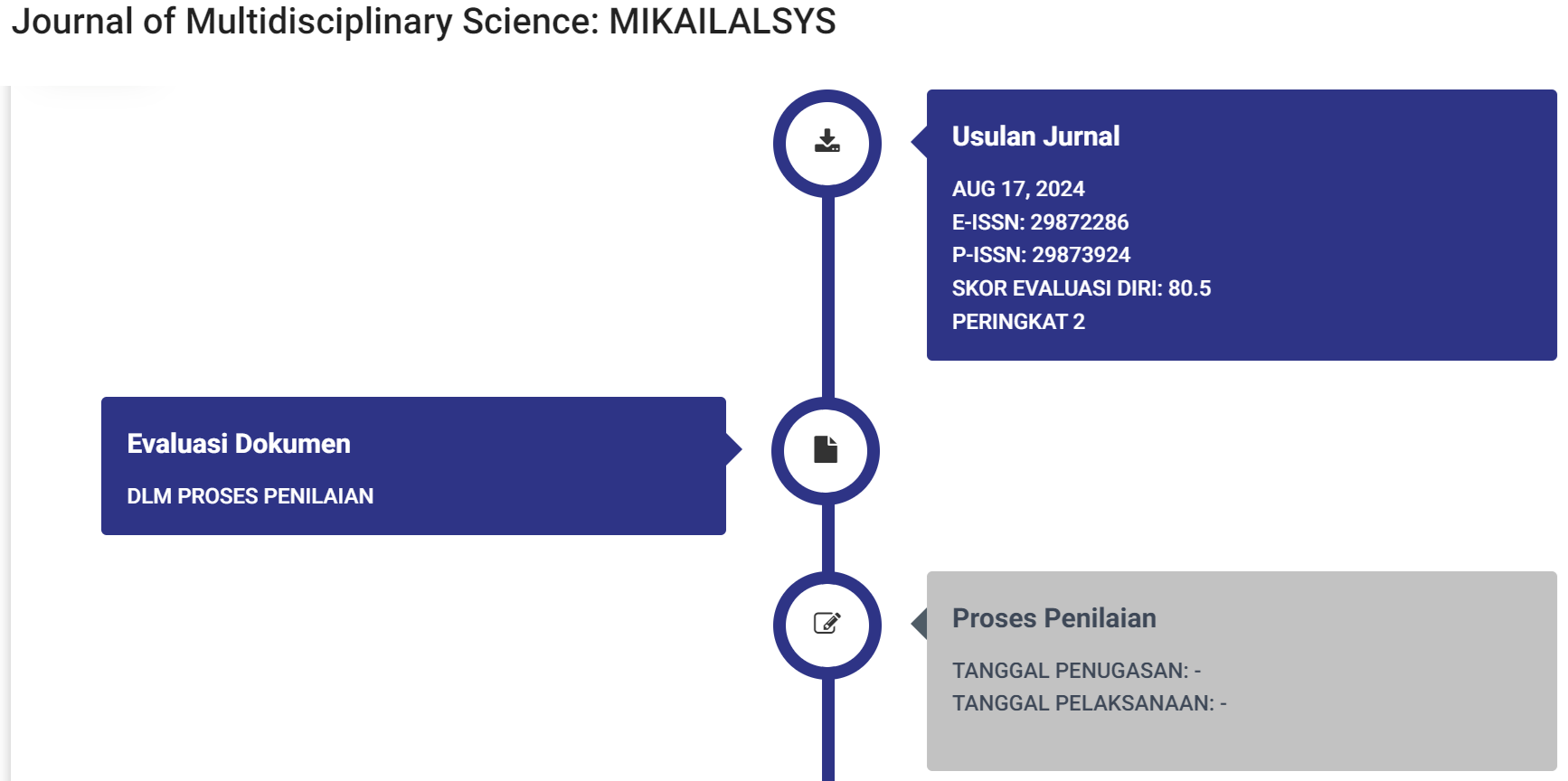Television Broadcast Media Adoption of Digital Platforms and Audience Engagement Within the Jalingo Metropolis
 Digital Object Identifier:
10.58578/mikailalsys.v2i3.3700
Digital Object Identifier:
10.58578/mikailalsys.v2i3.3700
Please do not hesitate to contact us if you would like to obtain more information about the submission process or if you have further questions.

Abstract
This study investigated mainstream television adoption of digital platforms and audience engagement to determine the level of audience engagement, motivation for engagement, and challenges associated with engagement with TV stations on their digital platforms. The study focuses on Channels TV and the Nigeria Television Authority (NTA). A mixed research method was adopted, and the population of the study was viewers of Channels TV and NTA in the Jalingo metropolis. Data were collected from a valid sample of 331 respondents through a questionnaire and analyzed using descriptive statistical tools. The study found a moderate level of audience engagement on the digital platforms of the TV outlets. The study further revealed that the audience is motivated to engage with the stations via digital platforms based on their desire to stay updated and the convenience and interactivity offered by digital platforms. However, the study revealed that issues of slow loading times, low video streaming quality, high data consumption, and outdated content were the major challenges impeding audience engagement with Television outlets via the digital platform. The study recommends that TV stations should prioritize the production of high-quality content on their digital platforms and ensure regular updates of information and interactivity on their platforms.




Citation Metrics:

Downloads

Authors retain copyright and grant the journal right of first publication with the work simultaneously licensed under a Creative Commons Attribution-NonCommercial-ShareAlike 4.0 International License that allows others to share the work with an acknowledgement of the work's authorship and initial publication in this journal.
References
Alejandro, J. (2010). Journalism in the age of social media. Reuters Institute Fellowship Paper, University of Oxford, 2009-2010.
Apuke, O. D., & Omar, B. (2021). The ethical challenges and issues of online journalism practice in Nigeria: What do professionals and academics think? Technology in Society, 67, 101713. https://doi.org/10.1016/j.techsoc.2021.101713
Baran, S.J. (2010). Introduction to Mass Communication Media Literacy and Culture. McGrawHill, New York.
Bureš, V., Mikulecká, J., & Ponce, D. (2017). Digital Television as a Usable Platform for Enhancement of Learning Possibilities for the Elderly. SAGE Open, 7(2). https://doi.org/10.1177/2158244017708817
Chadha, M., Kwon, K. H., & Tsai, J.-Y. (2022). An Examination of Affiliate and Network Television Channels’ Facebook Use for Addressing Audiences’ Critical Information Needs. Electronic News, 16(3), 164-186. https://doi.org/10.1177/19312431221093090
Carpentier, N., & De Cleen, B. (2007). Bringing Discourse Theory into Media Studies. Journal of Language and Politics, 6(2), 265–293. https://doi.org/10.1075/jlp.6.2.08car
Deery, J. (2003). ‘TV.com: Participatory Viewing on the Web’. Journal of Popular Culture, 37, 2003, pp. 161–183.
Deuze, M. (2009). Media industries, work, and life. European Journal of Communication, 24(4), 467–480. https://doi.org/10.1177/0267323109345523
Di Gangi, P. M., & Wasko, M. M. (2016). Social Media Engagement Theory: Exploring the Influence of User Engagement on Social Media Usage. Journal of Organizational and End User Computing (JOEUC), 28(2), 53-73.
Fossen, B. L., & Bleier, A. (2021). Online program engagement and audience size during television ads. Journal of the Academy of Marketing Science, 49(4), 743–761. https://doi.org/10.1007/s11747-021-00769-z
García-Avilés, Jose. (2012). Roles of audience participation in multiplatform television: From fans and consumers to collaborators and activists. Participations. Journal of Audience and Reception Studies. 9. 429-447.
Hampton, K., Goulet, L. S., Rainie, L., & Purcell, K. (2011). Social Networking Sites and Our Lives (Vol. 1). Washington DC: Pew Internet & American Life Project.
Hanna, K. T. (2023, February 1). Digital television (DTV). WhatIs.com. https://www.techtarget.com/whatis/definition/digital-television-DTV
Jenkins, H. (2006). Convergence culture: Where old and new media collide. New York University press
Kumar, T., Sharma, P., Tanwar, J., Alsghier, H., Bhushan, S., Alhumyani, H., Sharma, V., & Alutaibi, A. I. (2024). Cloud‐based video streaming services: Trends, challenges, and opportunities. CAAI Transactions on Intelligence Technology, 9(2), 265–285. https://doi.org/10.1049/cit2.12299
Livingstone, S., & Lunt, P. (2014). 31. Mediatization: an emerging paradigm for media and communication research? In De Gruyter eBooks (pp. 703–724). https://doi.org/10.1515/9783110272215.703
Molyneux, L., & Zamith, R. (2020). Surveying journalists in the “New Normal”: Considerations and recommendations. Journalism: Theory, Practice & Criticism, 23(1), 153–170. https://doi.org/10.1177/1464884920935277
Nee, R. C., & Dozier, D. M. (2017). Second screen effects: Linking multiscreen media used to television engagement and incidental learning. Convergence, 23(2), 214-226. https://doi.org/10.1177/1354856515592510
Ocholi, D. (2009, August 16). “A new dawn in the broadcast industry” Newswatch
Olaide, A., E, C. P., Bisola, E., Olanrewaju, F., & Adekunbi, L. (2016). Synergy between Conventional Television Broadcasting in Nigeria and the New Media in the Era of Digitization. SSRG International Journal of Communication and Media Science, 3(1), 1–5. https://doi.org/10.14445/2349641x/ijcms-v3i1p101
Prakash, A. (2023, October 4). How digital technology is transforming broadcast media? Appventurez. https://www.appventurez.com/blog/how-digital-technology-is-revamping-broadcast-media
Rainie, H. & Rainie, Lee & Wellman, Barry. (2012). Networked: The New Social Operating System.
Royakkers, L. L., Timmer, J., Kool, L., & Van Est, R. (2018). Societal and ethical issues of digitization. Ethics and Information Technology, 20(2), 127–142. https://doi.org/10.1007/s10676-018-9452-x
Shin, D., An, H., & Kim, J. H. (2015). How the second screens change the way people interact and learn: the effects of second screen use on information processing. Interactive Learning Environments, 1-22.
Tsai, H. S., & Lin, H. (2022). Social TV and Audience engagement: investigating the relationship between Facebook engagement and the TV performance of The Voice (USA). Online Information Review, 47(3), 453–468. https://doi.org/10.1108/oir-06-2021-0293
Walvaart, M. T., Van Den Bulck, H., & Dhoest, A. (2017). Engaging the audience in a digitized television production process. Journalism Practice, 12(7), 901–917. https://doi.org/10.1080/17512786.2017.1343093

























